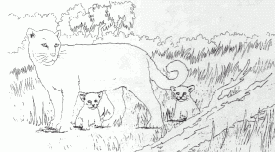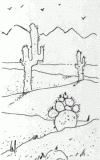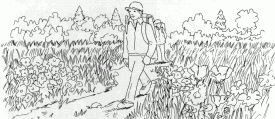Learn more about Threatened and Endangered Species
What Are Endangered and Threatened Species? 
A century ago, a bird called the passenger pigeon lived in North America. There were so many passenger pigeons that people often saw great flocks of them flying overhead containing thousands, even millions, of birds. Today, there is not a single one left. What happened?
The passenger pigeon became extinct. All living passenger pigeons disappeared from the earth entirely. The passenger pigeon became extinct for two reasons. First, the forests where it lived were cut down to make way for farms and cities. Second, many pigeons were shot for sport and because they were good to eat. At that time, there were no hunting laws to protect endangered species like there are now.
There are over 1,300 endangered or threatened species in the United States today. Endangered species are those plants and animals that have become so rare they are in danger of becoming extinct. Threatened species are plants and animals that are likely to become endangered within the foreseeable future throughout all or a significant portion of its range.
How Does Extinction Happen?
Species disappear because of changes to the earth that are caused either by nature or by the actions of people. Sometimes a natural event, like a volcano erupting, can kill an entire species. Other times, extinction will happen slowly as nature changes our world. For example, after the Ice Ages, when the glaciers melted and the earth became warmer, many species died because they could not live in a warmer climate. Newer species that could survive in a warmer environment took their places.
People can also cause the extinction of plants and animals. The main reason that many species are endangered or threatened today is because people have  changed the homes or habitats upon which these species depend. A habitat includes not only the other plants and animals in an area, but all of the things needed for the species' survival -- from sunlight and wind to food and shelter. The United States has many habitats, from ocean beaches to mountain tops. Every species requires a certain habitat in order to live. A cactus, for example, needs the sunny, dry desert in order to grow. A polar bear, on the other hand, would not live in a desert, because it could not find enough food and water.
changed the homes or habitats upon which these species depend. A habitat includes not only the other plants and animals in an area, but all of the things needed for the species' survival -- from sunlight and wind to food and shelter. The United States has many habitats, from ocean beaches to mountain tops. Every species requires a certain habitat in order to live. A cactus, for example, needs the sunny, dry desert in order to grow. A polar bear, on the other hand, would not live in a desert, because it could not find enough food and water.
Pollution can also affect wildlife and contribute to extinction. The Nashville crayfish is endangered mainly because the creek where it lives has been polluted by people.
Pesticides and other chemicals can poison plants and animals if they are not used correctly. The bald eagle is one bird that was harmed by pesticides. In the past, a pesticide called DDT was used by many farmers. Rains washed the pesticide into the lakes and streams where it poisoned fish. After eating the poisoned fish, the eagles would lay eggs with very thin shells. These eggs were usually crushed before they could hatch. Today, people are not allowed to use DDT, and this has contributed to the bald eagle being removed from the endangered and threatened species lists.needed for the species' survival -- from sunlight and wind to food and shelter.
The United States has many habitats, from ocean beaches to mountain tops. Every species requires a certain habitat in order to live. A cactus, for example, needs the sunny, dry desert in order to grow. A polar bear, on the other hand, would not live in a desert, because it could not find enough food and water.
People can also endanger plants and animals by moving, or introducing, new species into areas where they do not naturally live. Some of these species do so well in their new habitat that they endanger those species already living there, called the native species. These introduced species are called invasive species. For example, when some fish are introduced into a lake or stream, they may prey upon, or eat the food of the native fish. The native species may then have to find a new source of food or a new home, or face becoming endangered or extinct.
Another way that people harm animals and plants is by taking them from the wild. Some people might catch an insect like the Mission blue butterfly for a butterfly collection. Others might capture a wild animal for a pet, or pick a flower because it's pretty. In addition, some people illegally hunt animals for food, skins, or fur. In the past, lots of American crocodiles were killed so that their skins could be made into shoes and other clothing. This crocodile is now an endangered species.
Why Protect Endangered and Threatened Species?
Can you imagine walking in the woods without hearing birds singing, or picture what a field would be like without wildflowers blooming? Our plants and wildlife  make the world a more interesting and beautiful place. More importantly, all living species, including people, depend on other species for survival. For example, if a fish such as the shortnose sturgeon becomes extinct, all of the species that rely on it will also suffer and may become threatened or endangered.
make the world a more interesting and beautiful place. More importantly, all living species, including people, depend on other species for survival. For example, if a fish such as the shortnose sturgeon becomes extinct, all of the species that rely on it will also suffer and may become threatened or endangered.
We all depend upon plants and wildlife. From studying them, we have learned new ways of growing food, making clothing, and building houses. Scientists have discovered how to use certain plants and animals as medicine. If we fail to protect threatened or endangered species, we will never know how they might have improved our lives.
Endangered and threatened species need our help. Government agencies, such as the U.S. Environmental Protection Agency, the U.S. Department of  Agriculture, the U.S. Fish and Wildlife Service, NOAA's National Marine Fisheries Service, and the National Park Service, along with state fish and wildlife agencies and private groups are making information available so people can better protect endangered and threatened species and their habitats. You can contact these agencies for information and join the challenge in helping to protect endangered and threatened species, and all wildlife, from extinction.
Agriculture, the U.S. Fish and Wildlife Service, NOAA's National Marine Fisheries Service, and the National Park Service, along with state fish and wildlife agencies and private groups are making information available so people can better protect endangered and threatened species and their habitats. You can contact these agencies for information and join the challenge in helping to protect endangered and threatened species, and all wildlife, from extinction.
